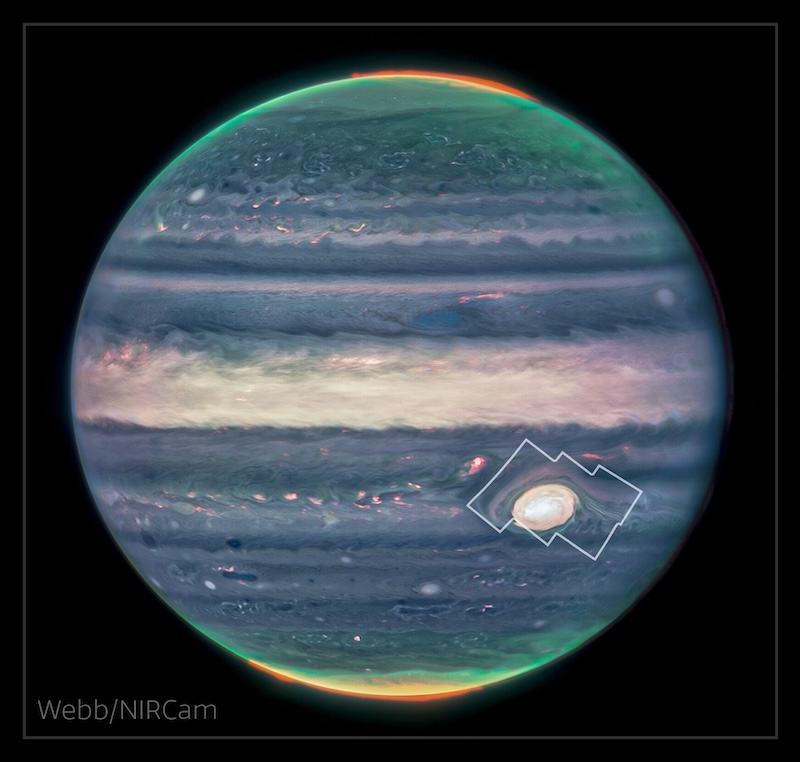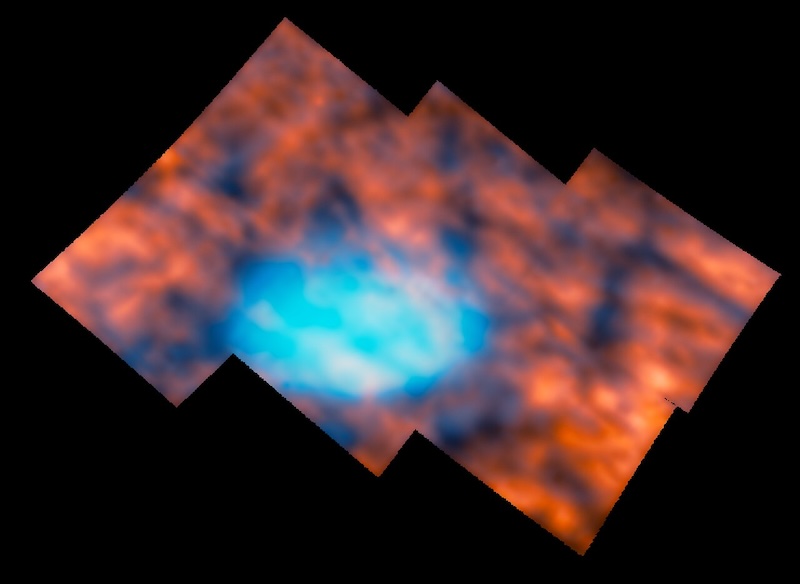
- The atmosphere above Jupiter’s Great Red Spot is active and dynamic. That’s according to astronomers who observed it with the James Webb Space Telescope, who expected it to be calmer.
- Webb found a surprising amount of activity, including dark arcs and bright spots across the whole field of view of the telescope.
- Gravity waves in the atmosphere may be creating the unexpected amount of complexity in the region above the Great Red Spot.
Jupiter’s Great Red Spot has surprises
Jupiter’s Great Red Spot is a 190-year-old storm larger than Earth. Yet scientists thought the atmosphere above the storm was rather benign and uneventful. But on June 24, 2025, astronomers said they used NASA’s James Webb Space Telescope to discover the region is not as bland as expected. In fact, they found a variety of previously unseen atmospheric shapes and structures.
The international team of researchers published their peer-reviewed findings in Nature Astronomy on June 21, 2024.
Observing the region above Jupiter’s Great Red Spot
The Great Red Spot is a massive storm on Jupiter that swirls in a counterclockwise motion. It’s a turbulent and chaotic place, to be sure. But scientists thought the upper atmosphere directly above the spot was much calmer, almost boring, even. They thought the atmosphere in this region would be more homogenous, due to the fact that Jupiter receives only 4% of the sunlight Earth does. Therefore, there should be a lot less influence on the atmosphere by sunlight.
There are, however, bright auroras at Jupiter’s poles. These auroras are the result of volcanic material from Jupiter’s moon Io hitting the planet’s magnetic field just above the upper atmosphere.
The researchers wanted to take a closer look at the region just above the Great Red Spot. They used the Near-InfraRed Spectrograph (NIRSpec) on Webb for the observations in July 2022. The research team focused on the atmosphere over the Great Red Spot.
Did you know that Jupiter’s Great Red Spot is shrinking?
A surprising variety of intricate structures
To their surprise, this region turned out to be much more active than anticipated. Webb revealed dark arcs and bright spots across the entire field of view. Lead author Henrik Melin at the University of Leicester in the U.K. said:
We thought this region, perhaps naively, would be really boring. It is in fact just as interesting as the northern lights, if not more so. Jupiter never ceases to surprise.
As the paper stated:
Here, we present James Webb Space Telescope H3+ observations of Jupiter’s low-latitude ionosphere in the region of the Great Red Spot, showing unexpected small-scale intensity features such as arcs, bands and spots. Our observations may imply that the low-latitude ionosphere of Jupiter is strongly coupled to the lower atmosphere via gravity waves that superimpose to produce this complex and intricate morphology.

Why is this region above the Great Red Spot so active?
The researchers said sunlight alone can’t explain why the atmosphere above the Great Red Spot is so much more active than previously thought. One answer might be gravity waves. Melin explained:
One way in which you can change this structure is by gravity waves, similar to waves crashing on a beach, creating ripples in the sand. These waves are generated deep in the turbulent lower atmosphere, all around the Great Red Spot, and they can travel up in altitude, changing the structure and emissions of the upper atmosphere.
The researchers plan to do more follow-up observations to see how the arcs and spots move and change over time. You can see similar waves in Earth’s atmosphere sometimes, but they’re much weaker than the possible ones on Jupiter.
Just days ago, another group of astronomers also said the Great Red Spot is probably only about 190 years old in its current form. So it’s not the same storm that astronomers first saw in the 1600s.
Juice mission
In July 2031, ESA’s Jupiter Icy Moons Explorer (Juice) will arrive at Jupiter. Juice will study Jupiter and three of its largest moons – Ganymede, Callisto and Europa – in incredible detail. It will be able to observe the Great Red Spot and atmosphere up close.
Bottom line: The Webb space telescope observed Jupiter’s Great Red Spot and found the atmosphere above the spot is much more active and dynamic than astronomers expected.
Source: Ionospheric irregularities at Jupiter observed by JWST
Read more: Jupiter’s Great Red Spot is 190 years old, scientists say
Read more: Jupiter’s Great Red Spot is shrinking! See photos
The post Atmosphere over Jupiter’s Great Red Spot surprisingly active first appeared on EarthSky.
from EarthSky https://ift.tt/481rFBZ

- The atmosphere above Jupiter’s Great Red Spot is active and dynamic. That’s according to astronomers who observed it with the James Webb Space Telescope, who expected it to be calmer.
- Webb found a surprising amount of activity, including dark arcs and bright spots across the whole field of view of the telescope.
- Gravity waves in the atmosphere may be creating the unexpected amount of complexity in the region above the Great Red Spot.
Jupiter’s Great Red Spot has surprises
Jupiter’s Great Red Spot is a 190-year-old storm larger than Earth. Yet scientists thought the atmosphere above the storm was rather benign and uneventful. But on June 24, 2025, astronomers said they used NASA’s James Webb Space Telescope to discover the region is not as bland as expected. In fact, they found a variety of previously unseen atmospheric shapes and structures.
The international team of researchers published their peer-reviewed findings in Nature Astronomy on June 21, 2024.
Observing the region above Jupiter’s Great Red Spot
The Great Red Spot is a massive storm on Jupiter that swirls in a counterclockwise motion. It’s a turbulent and chaotic place, to be sure. But scientists thought the upper atmosphere directly above the spot was much calmer, almost boring, even. They thought the atmosphere in this region would be more homogenous, due to the fact that Jupiter receives only 4% of the sunlight Earth does. Therefore, there should be a lot less influence on the atmosphere by sunlight.
There are, however, bright auroras at Jupiter’s poles. These auroras are the result of volcanic material from Jupiter’s moon Io hitting the planet’s magnetic field just above the upper atmosphere.
The researchers wanted to take a closer look at the region just above the Great Red Spot. They used the Near-InfraRed Spectrograph (NIRSpec) on Webb for the observations in July 2022. The research team focused on the atmosphere over the Great Red Spot.
Did you know that Jupiter’s Great Red Spot is shrinking?
A surprising variety of intricate structures
To their surprise, this region turned out to be much more active than anticipated. Webb revealed dark arcs and bright spots across the entire field of view. Lead author Henrik Melin at the University of Leicester in the U.K. said:
We thought this region, perhaps naively, would be really boring. It is in fact just as interesting as the northern lights, if not more so. Jupiter never ceases to surprise.
As the paper stated:
Here, we present James Webb Space Telescope H3+ observations of Jupiter’s low-latitude ionosphere in the region of the Great Red Spot, showing unexpected small-scale intensity features such as arcs, bands and spots. Our observations may imply that the low-latitude ionosphere of Jupiter is strongly coupled to the lower atmosphere via gravity waves that superimpose to produce this complex and intricate morphology.

Why is this region above the Great Red Spot so active?
The researchers said sunlight alone can’t explain why the atmosphere above the Great Red Spot is so much more active than previously thought. One answer might be gravity waves. Melin explained:
One way in which you can change this structure is by gravity waves, similar to waves crashing on a beach, creating ripples in the sand. These waves are generated deep in the turbulent lower atmosphere, all around the Great Red Spot, and they can travel up in altitude, changing the structure and emissions of the upper atmosphere.
The researchers plan to do more follow-up observations to see how the arcs and spots move and change over time. You can see similar waves in Earth’s atmosphere sometimes, but they’re much weaker than the possible ones on Jupiter.
Just days ago, another group of astronomers also said the Great Red Spot is probably only about 190 years old in its current form. So it’s not the same storm that astronomers first saw in the 1600s.
Juice mission
In July 2031, ESA’s Jupiter Icy Moons Explorer (Juice) will arrive at Jupiter. Juice will study Jupiter and three of its largest moons – Ganymede, Callisto and Europa – in incredible detail. It will be able to observe the Great Red Spot and atmosphere up close.
Bottom line: The Webb space telescope observed Jupiter’s Great Red Spot and found the atmosphere above the spot is much more active and dynamic than astronomers expected.
Source: Ionospheric irregularities at Jupiter observed by JWST
Read more: Jupiter’s Great Red Spot is 190 years old, scientists say
Read more: Jupiter’s Great Red Spot is shrinking! See photos
The post Atmosphere over Jupiter’s Great Red Spot surprisingly active first appeared on EarthSky.
from EarthSky https://ift.tt/481rFBZ

Aucun commentaire:
Enregistrer un commentaire